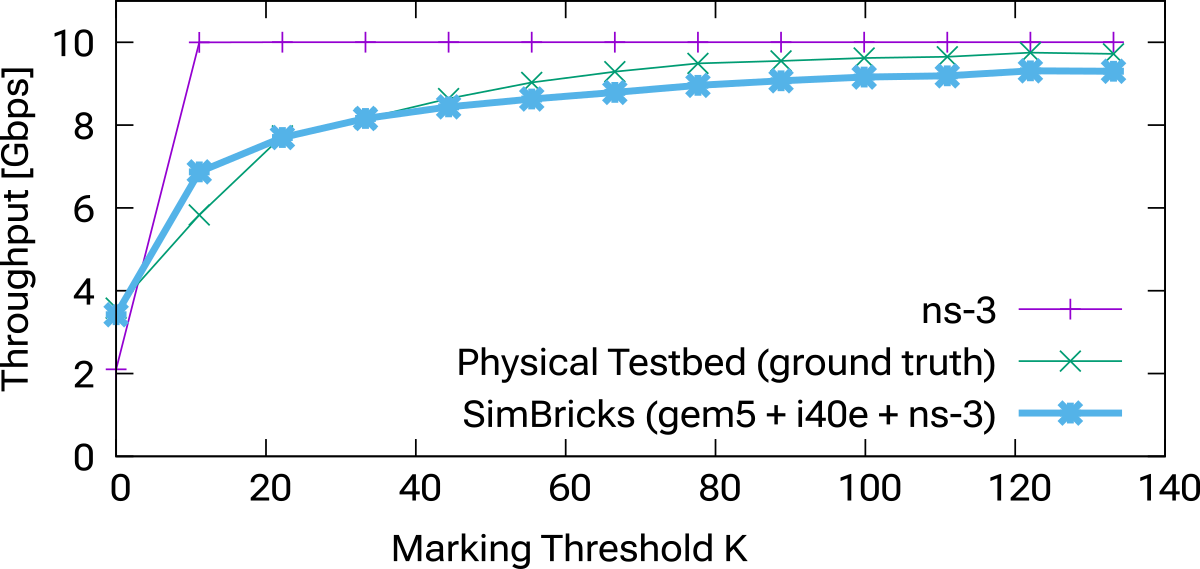In our previous blog post we had a look at how SimBricks enables modular full system simulation. By combining different best-of-breed simulators, SimBricks effectively enables end-to-end evaluation in simulation. But why should you care about full system simulations instead of sticking with the status quo of simulating only specific parts of the system in isolation? This post sheds light on when and why you should care about end-to-end evaluation.
Full System Simulation Provides the Whole Picture
Modern computer systems consist of many interconnected components. For example, CPUs might be connected to memory, NICs, GPUs, and much more. Networks are naturally highly interconnected systems that consist of many different components. And the trend towards increasingly interconnected systems is continuing with the advent of new technologies such as hardware resource disaggregation. Thus individual components rarely operate completely detached from the rest of the system. Instead, the decisive factor for the behavior and performance of a component is often how it interacts with other components in the system.
For example, if we develop a new accelerator that is connected via PCIe, it is of no benefit if the accelerator can perform calculations quickly and efficiently, but cannot communicate efficiently with the rest of the system. In this case, the interface to the rest of the system becomes a bottleneck and prevents the accelerator from reaching its true potential. Therefore, a meaningful evaluation of these systems, requires us to look at all system components in combination.
Existing Individual Simulators Are Not Enough
Current simulators only simulate parts of most typical systems today. Different simulators focus on simulating different subsets of system components. They either completely skip simulating other components, or rely on overly simplified or abstracted models for them. For example, the network simulator ns-3, simulates the behavior of a network well, but only uses a very abstract, functional model for the end-hosts. Many aspects of the host systems are not modeled, even though they can have a noticeable effect on the performance of the entire system. We therefore use SimBricks to simulate each relevant component in detail with a separate best-of-breed simulator. This allows us to perform actual end-to-end full-system evaluation in simulation.
End-To-End Evaluation Makes a Difference

To show that end-to-end simulation can make a difference, let’s look at an experiment we conducted in our paper. In this experiment we compared the dctcp congestion control algorithm in the ns-3 network simulator to a physical testbed and SimBricks end-to-end simulation. We set up two clients and two servers sharing a bottleneck link and one large TCP flow for each client-server pair. In the case of SimBricks, we use a combination of gem5, ns-3 and an Intel i40e NIC simulator to simulate hosts, network and NICs in detail. The graph above shows the throughput for varying the dctcp parameter K. The marking threshold balances queuing latency and throughput; a lower threshold reduces queue length but risks under-utilizing links. Ns-3 underestimates the necessary threshold to achieve line rate, as it does not model host processing variations, particularly processing delay caused by OS interrupt scheduling. However, SimBricks uses gem5 for a detailed simulation of the host and thus captures host processing variations resulting in measurements that more closely match with those of the physical testbed. We conclude only an end-to-end evaluation of the full system captures such intricacies.
We hope that we have been able to convince you that you should conduct end-to-end evaluations using full system simulations. If you have any question:

 Marvin Meiers
Marvin Meiers



